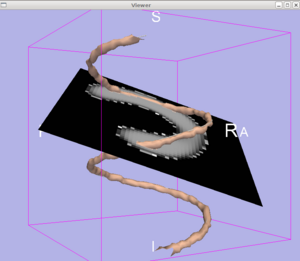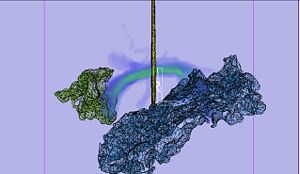DBP2:Harvard:Brain Segmentation Roadmap
Back to NA-MIC Collaborations, Harvard DBP 2
Stochastic Tractography for VCFS
Roadmap
The main goal of this project is to develop end-to-end application that would be used to characterize anatomical connectivity abnormalities in the brain of patients with velocardiofacial syndrome (VCFS), and to link this information with deficits in schizophrenia. This page describes the technology roadmap for stochastic tractography, using newly acquired 3T data, NAMIC tools and slicer 3.
Algorythm
A-Description
|
B - Possible Applications
|
- C - References
- Björnemo M, Brun A, Kikinis R, Westin CF. Regularized stochastic white matter tractography using diffusion tensor MRI. In Fifth International Conference on Medical Image Computing and Computer-Assisted Intervention (MICCAI'02). Tokyo, Japan, 2002;435-442.
- Friman, O., Farneback, G., Westin CF. A Bayesian Approach for Stochastic White Matter Tractography. IEEE Transactions on Medical Imaging, Vol 25, No. 8, Aug. 2006
Module
Fill it in once its ready. Write exactly, step by step what is its functionality, adding snapshots:
- Loading DTI in Nrrd format
- eddy current distortion correction
- movement correction
- smoothing
- tensor estimation
- creating WM mask
- loading rois
- creating probability map
- visual inspection (looking at areas where mask does not exist, but FA exceeds 0.3)
- thresholding
- visualizing path, tracts
- getting numbers (thresholded FA, FA weighted by probability)
- Module documentation can be found here (replace with the new documentation, when its ready):
Work Accomplished
- A - Optimization and testing of stochastic tractography algorythm
- Original methodological paper, as well as our first attempts to use the algorythm (CC+ and matlab scripts) have been done on old "NAMIC" 1.5T LSDI data (Structural MRI and DTI data).
- Tri worked hard on making sure algorythm works on new high resolution 3T data (available here: 3T Data).
- Tests have been done also on the spiral diffusion phantom, to make sure diffusion directions and scanner coordinates are handled properly by the algorythm (Figure 5).
- B - Clincal Applications
- Algorythm was used to trace and analyze anterior limb of the internal capsule on 1.5T data. It generated reacher representation of frontal fiber projections, it also turned out to be more sensitive to group differences in white matter integrity that conventional deterministic tractography (see Figure 4).
- Algorythm was also used to trace smaller white matter fiber tracts, such as Cingulum, Fornix, Uncinate Fasciculus, Arcuate Fasciculus on 3T "Santa Fe" dataset (http://www.na-mic.org/Wiki/index.php/SanteFe.Tractography.Conference)
- C - References
Work in Progress
- A - Optimization and Testing of stochastic tractography module
-
- Julien is testing now separate components of work flow, including the masks, and impact of their precision on stochastic output, as well as impact of number of seeding points on tractography results.
- At the same time, we are testing the module on Max Plank dataset, as well as running it on tractography comparison project dataset.
- We are discussing possibility of adding project specific functionality to module, such as third ROI to guide tractography, nonlinear registration button for merging fMRI and DTI data.
- B - Related Clinical Projects
- Arcuate Fasciculus Extraction Project
We have started the project of investigating Arcuate Fasciculus using Stochastic Tractography (Figure 6). This structure is especially important in both VCFS and schizophrenia, as it connects language related areas (Brocka and Wernicke's), and is involved in language processing quite disturbed in schizophrenia patients. It also can not be reliably traced using deterministic tractography.
- Project involves:
- Whole brain segmentation, and automatic extraction of regions interconnected by Arcuate Fasciculus (Inferior frontal and Superior Temporal Gyri).
- White matter segmentation, in order to prevent algorithm from traveling through the ventricles, where diffusivity is high.
- Non-linear registration of labelmaps to the DTI space.
- Seeding tracts. We have piloted it using 5000 seeds per voxel, however it is quite time consuming running it on even most powerful computers in the lab, so we have experimented with smaller number of seeds per voxel. We tested 1000 seeds, which gave virtually identical results.
- Extracting path of interest, and calculating FA along the path for group comparison. Presentation of previous results for 7 schizophrenics and 12 control subjects, can be found here: Progress Report Presentation.
- Results presentation and paper submission. Abstract was submitted and accepted for presentation at World Biological Psychiatry Symposium in Venice, Italy. Paper is in preparation.
- Semantic Network Connectivity Project
We use combination of fMRI and DTI data to define and characterize functional and anatomical connectivity within the semantic processing network in schizophrenia.
- Project involves:
- fMRI data analysis and identification of functional nodes involved in semantic processing in healthy controls and seubjects with schizophrenia
- Analysis of functional connectivity (using FSL) between nodes of semantic network
- Whole brain Voxel Based analysis of DTI data in same population
- Use of stochastic tractography to identify connections between functional nodes
- Correlational analysis involving anatomical and functional connectivity data.
- Results presentation and paper submission. Data was presented at HBM conference in 2007, paper has been submitted to HBM.
- Study of Default Network
We have started collaboration with Department of Neurophysiology Max Planck Institute in Frankfurt (Anna Rotarska contact person). They have dataset containing DTI and resting state fMRI in schizophrenia, and want to use stochastic tractography to measure integrity of anatomical connections within the default network in schizophrenia. Their fMRI data has been co-registered with anatomical scans, and we are putting it into the DTI space. Once this is done, we will start creating tracts connecting fMRI ROIs. This data will be also used to test robustness of our module, since data was collected on a different scanner (3T Philips).
- Tractography Comparison Project
We are also working on a tractography comparison projectdataset, where we apply stochastic tractography to phantom, as well as test dataset.
Staffing Plan
- Sylvain and Yogesh are the DBP resources charged with adapting the tools in the NA-MIC Kit to the DBP needs
- Doug Markant, our NAMIC RA has left the lab, and now Doug Terry, is a new NAMIC RA.
- Julien is our new NAMIC software engineer. He is responsible for improving the STM (Stochastic Tractography Module), and making sure software works with STM compliant datasets. Progress
- Polina is the algorithm core contact
- Brad is the engineering core contact
Schedule
- 10/2007 - Optimization of Stochastic Tractography algorythm for 1.5T data.
- 10/2007 - Algorythm testing on Santa Fe data set and diffusion phantom.
- 06/2008 - Optimization of Stochastic Tractography algorythm for 3T data.
- 11/2008 - Slicer 3 module prototype using python.
- 12/2008 - Slicer 3 module official release
- 12/2008 - Documentation and packaging for dissemination.
- 12/2008 - Arcuate Fasciculus results.
- 01/2009 - Arcuate Fasciuclus first draft of the paper.
- 05/2009 - Distortion correction and nonlinear registration added to the module
- 05/2009 - Symposium on tractography, including stochastic methods at World Biological Psychiatry Symposium in Venice, Italy.
- 05/2009 - Presentation of Arcuate Fasciculus findings at World Biological Psychiatry Symposium in Venice, Italy.
Team and Institute
- PI: Marek Kubicki (kubicki at bwh.harvard.edu)
- DBP2 Investigators: Sylvain Bouix, Yogesh Rathi, Julien de Siebenthal
- NA-MIC Engineering Contact: Brad Davis, Kitware
- NA-MIC Algorithms Contact: Polina Gollard, MIT
Publications
In print





